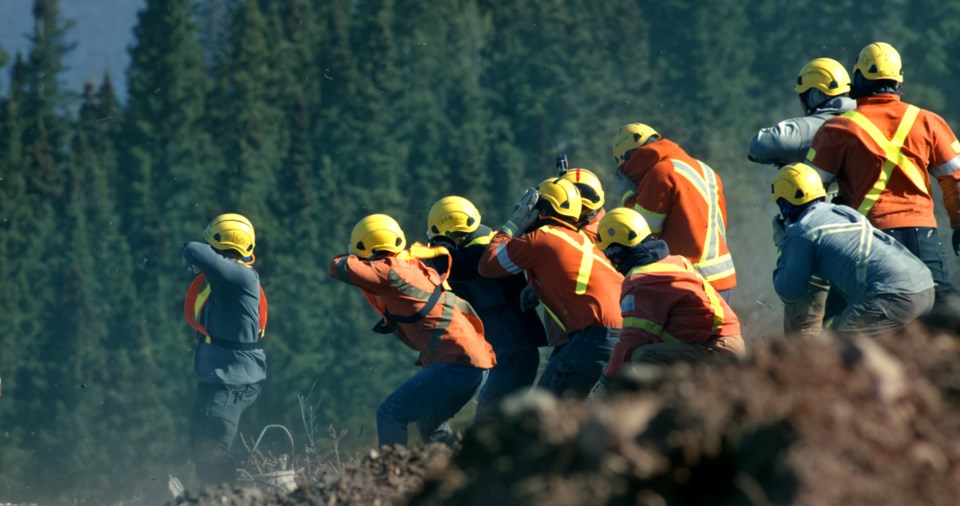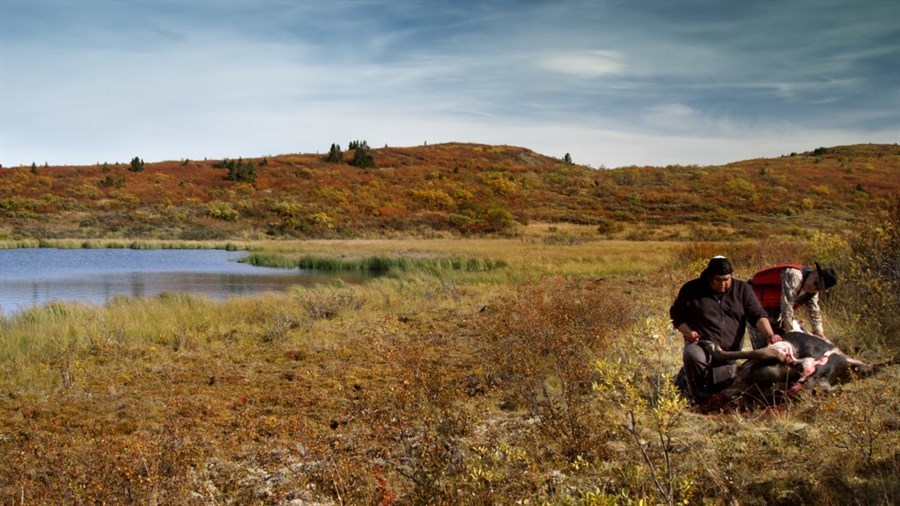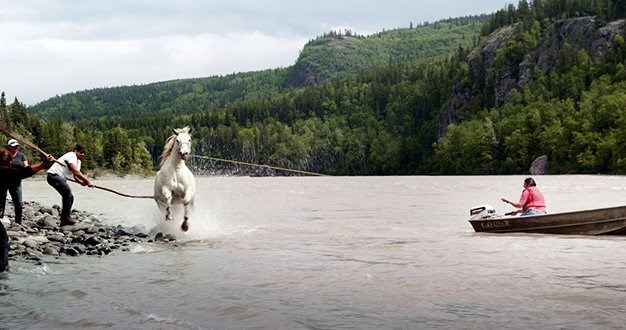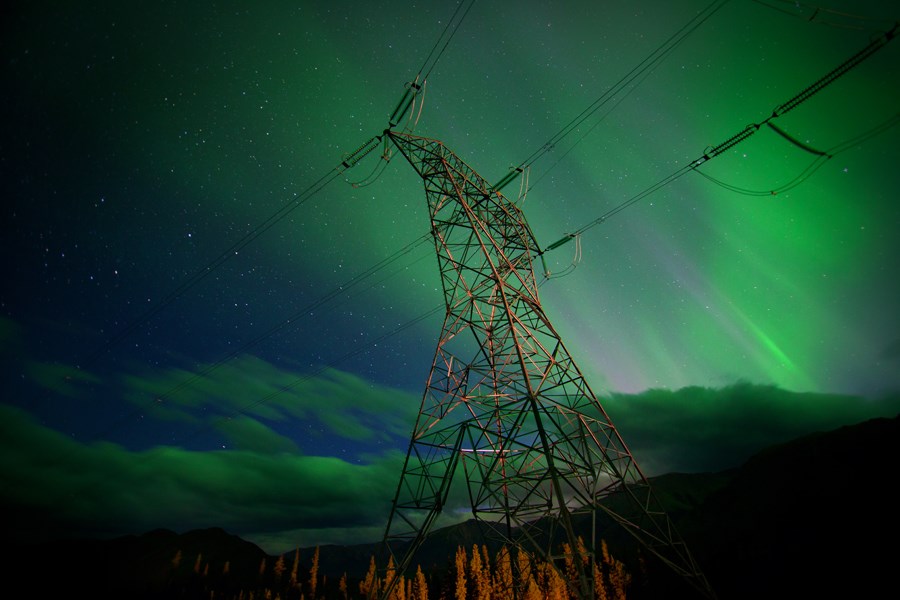Early in the filming of her latest documentary, KONELINE, Nettie Wild says there was a specific sequence that would establish the tone and approach of her entire film. Wild and her crew were in a remote area of northwestern B.C. on the side of a mountain, filming giant towers getting flown in for the Northwest Transmission Line, in slow motion with an 800 mm lens.
“Imagine the world's largest chopper carrying towers that are 16,000 lbs each over mountain tops, the sun bouncing off of them making them gleam like silver crosses, then landing them where a team of 10 linemen are made puny by the sheer scale of the towers and the gale force winds of the back wash of the chopper,” Wild says. “The ends of the towers swing like dangerous pendulums, the linemen dance… These images have the elegance of engineering, the dexterity of the linemen, the beauty of an extraordinary landscape and the environmental degradation of a clear cut. It’s all in the frame. There is no need for comment. We knew we had hit pay dirt. We had found the language of our film. From that point on we continued our search for poetry where we least expected it. And we continued to be surprised.”
KONELINE, which is the name the Tahltan First Nation calls the land they’ve lived on for thousands of years and means "our land beautiful," is both old and new territory for Wild. The filmmaker is well acquainted with northwestern B.C. and putting a personal face to conflict and power struggles. But unlike her previous films, which have explored everything from the Philippine revolution (A Rustling of Leaves), First Nations logging protests (Blockade), Mexico's Zapatista uprising (A Place Called Chiapas) or addiction and activism (Fixed), there is no clearly defined narrative or point of view to KONELINE, while the landscape, shot beautifully, becomes the primary character of the film.
Wild talked to the Courier via email about her new documentary, which opens tonight at Vancity Theatre.
Koneline looks unlike anything you’ve done before, in terms of structure, narrative, point of view. Was that something you set out to do from the start, or did the subject matter shape the end result?
I was spooked, overwhelmed — the tsunami of films out there with talking heads warning us about environmental catastrophe. It’s numbing. I figured if as a filmmaker I was pooped, my audience might be too. And then there is this polarized debate about how the heck we create a more sustainable planet. Not much listening going on. A roar of rhetoric. How to cut through it?
As an artist I had made a film in the northwest before, Blockade. I love that film. But here I was further north but facing the same universal story 20 years later. First Nations. Huge and beautiful landscape. Industrialization changing that landscape. I didn't want to make the same movie again.
I am used to shaping character-driven stories. And while I have always searched for beauty within my frame, my characters in the past have each voiced a side of a political argument. This time I didn't want to go down that character driven route which is closer to a polemic. Instead I wanted to reach out and see if I could find the poetry in everyone in front of my lens. Diamond drillers. Linemen working on the Northwest Transmission Line. A woman big game hunter swimming her herd of horses across the Stikine to get to her hunting grounds. White guys hunting sheep with bows and arrows. Tahltan hunting moose in trucks and with high powered rifles.
The challenge was to park my assumptions, and lean into the northwest with a curious lens, not a judgemental heart. See if I could be surprised by what I found in the people, what they did, and how we chose as a crew to formally frame them with our camera.

What attracts you to a subject?
In this case the landscape of the northwest moves me deeply. And that sense that something so big and beautiful is on the cusp of irrevocable change. It is compelling as hell.
I inherited a love of the bush from my mother and grandfather. I have explored a great deal of the northwest by foot and horseback. I have had the very real privilege of heading out into the wilderness with guide outfitters who know the land in a way that a hunter does. There is nothing like travelling through landscape and seeing it all from the back of a horse, its ears framing a constant dolly shot of changing and beautiful terrain.
I also inherited a mine from my grandfather. The only thing he loved more than fishing was chasing the glint of metal in the rock. He was a doctor. A city boy. But he was a dreamer too and that's what led him to be the controlling shareholder of Stannite mines — seven holes in the ground that mined more options that tungsten. My legacy. And with it a weird kind of understanding of this industry that pulls metal out of the earth that I use in every aspect of my life.
So KONELINE, like any good story, is both a personal as well as a universal story that appeals to me.

KONELINE took four years to complete. What was the most challenging aspect of making this film?
Access. Both the mining industry and the more militant members of the Tahltan First Nations were hard to approach. Really hard. It’s interesting. I have had better luck finding my way into death squads in the Philippines or revolutionary armies in Chiapas than the mining industry or a hard rock blockade on a mining road in northern B.C. I think that’s an indication of how polarized the debate has become. Everyone was circumspect that I was going to betray them. Reassuring them that I was making art didn't go far either. Thank heavens Harvey Trembley from Hi-Tech Drilling said yes instead of no to my camera. That led to filming his diamond drilling crews at the Bruce Jack mine… Harvey figures the mining industry has to enter into the greater conversation. And he started that conversation with me. Thank God. Partially I think because of my family mine. But mostly because I wanted to hear his stories and figure out how his head worked. Harvey is not in the film, but a lot of what he taught me is.
And the access problem was not limited to the mining industry. Tahltan hard liners demanded that I use my truck as part of the blockade — or lose access. I tried to explain that my camera was in the long run going to be more valuable to them than my truck. And that it was better for me to be a filmmaker than become an active part of the story in front of the lines. But to no avail. My refusal to become a part of the blockade (and the story I was filming) cost me my access to a crucial Tahltan blockade of the Red Chris mine.
In the end it was a liberation. It forced me away from the character/conflict driven story line of the past. It made me explore less obvious dynamics at play. And once again, I was surprised by what I found.
Instead of filming the mining side of the blockade, we filmed the flying in of the Northwest Transmission Line. Instead of following the central figures of the blockade, I ended up deep inside the Dennis family — linguist Oscar is racing against time to learn a dying language from his dying father. Where his mother Mary let me into her story present and past in a deeply nuanced way. Surprises — they are by nature found where you least expect them. That's where the art lies.

There’s a poetry to the visuals and the way they are assembled in this film. Was there any films or filmmakers that influenced you for this project and how you approached it?
Check out the opening of Feline's La Dolce Vita and then watch our flying transmission line scene and see what you think. Fellini is flying a crucifix over Rome in a fictional drama starring Marcello Mastroianni and the linemen are flying towers with struts that catch the morning light as they fly over mountains of the northwest. Truth is far stranger than fiction. And I would argue more beautiful.
With the proliferation of cheaper technology and the public’s ability/obsession with documenting every aspect of their lives, including what they eat for lunch, how does a documentary filmmaker break through all the digital noise to reach audiences?
Art. That's what we can bring. Searching for the abstract, not to be obtuse, but to frame the familiar in an unfamiliar way. That's when you surprise yourself as an artist. And if you can do that, you have a good chance of surprising your audience.
Is it easier or harder to reach audiences than when you first started making films?
It’s weirder. The old forms of broadcast and theatrical distribution are vaporizing. But right now it’s unclear exactly what if anything is taking its place. The web is still pretty ephemeral. It tantalizes with its amazing scope and speed and sheer (potential) numbers. But it doesn't create the village well of a cinema. A real time experience with fellow audience members. That is where KONELINE flourishes — on the big screen, with big sound and, hopefully, a big audience.
This interview was edited and condensed.



